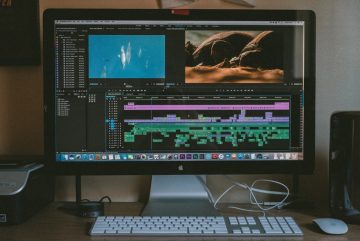(Way back…) in 1996, the New London Group postulated that “literacy pedagogy now must account for the burgeoning variety of text forms associated with information and multimedia technologies”
Spring ahead a few decades and it is clear that multiliteracy, including the ability to create multimedia has an increasingly essential place in today’s world. Today, multimodal texts generally refer to media that combine two or more modes: audio, visual, textual and even kinesthetic or sensorial. A multimodal creation may be digital but it also might be a play or other artwork or creation in the ‘real’ world. In the digital realm, I would include emerging media such as augmented and virtual reality as multimodal works. You might find this post from an earlier Make Create Innovate session at UBC-V in Fall 2019 of interest. Or this post on digital storytelling. Both include links to several tools you might use with students as they (and you) create media!
Below are some selected resources and tutorials to help in your (or your students) efforts to develop fluency!
Remember, a good piece of media relies upon a solid plan! UBC Studios has developed some comprehensive resources to support planning including storyboarding, location scouting and production.
Creating your Video:
Thanks to a partnership with the UBC Education Library, the Teacher Education Office is able to offer access to some excellent equipment to support video creation and hybrid teaching. Teacher Candidates, Instructors and Staff can borrow from the variety of equipment available. Below are some ‘quick start guides’ for each of the tools on loan (logitech Brio webcam, OSBOT tracking cam and mic, Lavalier mic, Voice amplifier and Yeti microphone). *They also have a variety of dongles on loan including USB to USB-C.
- Zip file (5 guides) – FW__Quick_Start_Guides_for_TEO_Equipment_Lending (1)
- Shidu Voice Amplifier User Guide
- Samson XPD2 Lavalier lapel mic User Guide
- OBSBOT tracking cam/mic Tiny User Guide
- Logitech BRIO Pro 4k Webcam User Guide
- Yeti multi directional podcast mic User Guide
Video Editing:
Camtasia
It is perfect for explainer videos and can be used to create any kind of video montage. As a UBC student, faculty or staff, you can have access to this robust yet fairly accessible editing and screen recording software. Camtasia allows you to capture video on your screen, import video, images, audio and do some editing to create your own video or montage. Features include adding ‘call outs’ or annotations such as arrows, boxes, text. On the Scarfe Digital Sandbox, we have a set of instructions to support you in downloading a licensed copy of Camtasia as well as a link to an assignment in which students created their own ‘explainer videos’ using Camtasia. This post includes a screen shot tutorial showing basic features that will help you get started. TechSmith, the maker of Camtasia, has its own youtube channel with many comprehensive video tutorials. Visit TechSmith’s website for a full set of video tutorials and resources. For those who prefer a paper handout – here is a pdf quick start guide shared via the Faculty of Ed’s own Ed Tech Support Unit.

iMovie and MovieMaker
Both are popular video editing softwares. The makers of each of these products have many tutorial resources available on their websites. Penn State also has a collection of iMovie and Final Cut tutorials worth checking out.
Viva Video
It is a free mobile video editor, it has easy drag and drop interface and one touch tools make this perfect for quick editing, video creation and sharing in the field! ShowMe and Explain Everything are excellent free options for ‘digital whiteboard’ productions by students of all ages (yes, even grades K and one!).
Housing and sharing your video:
Sharing video to Youtube or Teachertube and embedding on a website or sharing via URL is an efficient way to share video with others. Sometimes, however, we do not want to make content available in these platforms. In particular, when working with students, Canadian data housing and FIPPA compliance are essential.
Kaltura:
As UBC Faculty, Staff or Students, you have the option of using Kaltura – a UBC housed video platform. Using Kaltura, you can upload (apparently!) unlimited video content. This platform is also connected directly with our Learning Management System, Canvas, so an efficient use of time when creating and sharing video or lecture capture in a course. You can create your own channels, upload private or public video, share video with individuals or channels and even embed publicly on a website, a learning management system (like Canvas), in a tweet or instagram post depending on the privacy settings you select. You can edit, narrate and annotate video you upload and even share and comment on videos within a channel. One of my favourite features is adding ‘pause and reflect’ points in videos using the ‘quiz’ tool. To get started, login using your CWL to https://learning.video.ubc.ca/
Login:
Upload Media:
Share Via URL:
Add Timestamped Comments:
Set Permissions:
CLAS:
The Collaborative Learning Annotation System allows the sharing and annotation of video content. This platform is perfect for remote observation or viewing of micro-teaching. For example: One person can upload video of themselves teaching, make comments, annotations or add ‘call outs’ highlighting specific aspects of the video. Another (or anyone this video is shared with) can then make their own comments and annotations. These comments can appear in the video timeline, making it very clear to what aspect of the video or portion of the video is being commented on. This platform grew out of a TLEF (teaching learning enhancement fund grant) and has become a very robust and relatively user friendly environment that is also secure, FIPPA compliant and UBC housed! To get started, you will need an ‘instance’ created. UBC Faculty of Ed staff and faculty can contact Educational Technology Support (ETS) for information. To support use with Teacher Candidates and Faculty Advisors in the BEd program, we have consulted with school districts and have agreements including guidance documents and consent forms in place in most Coast Metro school districts. Please speak with your FA and contact Yvonne Dawydiak, Learning Design Manager, yvonne.dawydiak@ubc.ca or your Practicum Coordinator for more information and to have your secure, private CLAS instance ‘activated’. Access is via your CWL. Watch a video to learn more about CLAS.
References:
The New London Group (1996) A Pedagogy of Multiliteracies: Designing Social Futures. Harvard Educational Review: April 1996, Vol. 66, No. 1, pp. 60-93.
https://doi.org/10.17763/haer.66.1.17370n67v22j160u

